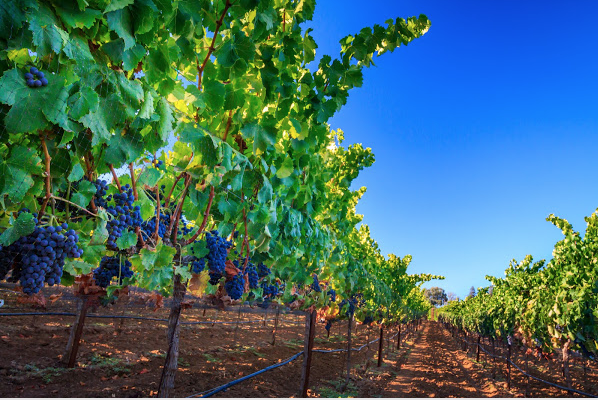
Bucking the long tradition of Bordeaux-style wines in this valley is a growing trend of Rhône-style wines. For many years, the wineries of Santa Clara Valley have produced wines made from cabernet sauvignon, merlot, syrah, zinfandel and other Italian varietals such as sangiovese and charbono. Without a real focus, our collective winemakers have produced a scatter-gun variety of wines—not really specializing in any one type of grape. Not that this is a bad thing, it’s just different than what many up-and-coming wineries are doing now; specializing in a wine type—specifically, Rhône styles.
Jeff Fadness, owner of one of our region’s newest wineries, La Vie Dansante Wines, says, “Our region is perfectly suited for Rhones—our warm days and cool nights are ideal conditions for flavorful wines, that are not over-ripe, with balanced natural acidity. Most summer nights, the temperature dips down into the low 50s giving the grapes a chance to recover from the heat of the day.”
For those wondering what the differences are between Bordeaux and Rhône wines, the general answer is that Bordeaux wines are produced only from grapes grown in the Bordeaux region of France; while Rhône wines are produced only from grapes grown in the Rhône region of France. Per strict European regulations, only certain grapes that have been proven to thrive in these regions may be grown, produced and labeled as these different wine styles.
Both Bordeaux and Rhône wines are typically blends—each made up of two or more types of grapes. Produced in the southwest region of France, Bordeaux wines are usually blends of cabernet sauvignon and merlot grapes. Several other varietals like cabernet franc, petit verdot and malbec are also permitted to be used in these blends.
Rhône grapes, grown in southeast France, include 22 varietals. Some of the more common red Rhônes include grenache, syrah and mourvedre grapes. And the more common white Rhônes contain viognier, roussanne and marsanne grapes.
Our winemakers are turning toward Rhône wines for their softer and less tannic qualities, compared to the traditional Bordeaux styles. They’ve also discovered that Rhône varietals are easy to grow, and in fact thrive, in the Santa Clara Valley. Not only do Rhône-style wines offer winemakers a refreshing change of pace, but they also give those consumers who prefer a more restrained, elegant wine, (over some of the Bordeaux fruit bombs), more wine options.
The Santa Clara Valley wineries specializing in Rhône-style wines are Aver Family Vineyards, Sarah’s Vineyard, La Vie Dansante mentioned above, and Lion Ranch Wines. Each winemaker has their own, unique story of how and why their passion for these wines developed.
After discovering that Rhône grapes were planted by early settlers in California, and thrived in our region since the 1800s, Tim Slater, the proprietor of Sarah’s Vineyard, has been on a mission to promote Rhône grape varietals. That was more than a decade ago, when he found success with his own plantings of Rhône grapes. “It was at this point that my interest became more of an obsession,” he says.
Then in 2008 while attending Le Cordon Bleu culinary school, he was mesmerized by the history and romance of the small Rhône village of Châteauneuf-du-Pape, where he tasted some of the greatest Rhône wines in the world. Slater noted the geographic similarities between the Rhône and Santa Clara valleys.
“It was then that I decided that Rhône varietals needed to be re-energized and planted the most critical varietals including grenache, viognier, roussanne, grenache blanc, picpoul blanc, clairette blanche, counoise, and mourvèdre,” he says.
Kim and Todd Engelhardt of Lion Ranch Wines say that living in San Francisco developed their love of fine foods and palates for fruit-forward, high-acid and restrained oak-style wines. They soon discovered that they both favored Rhône wines, especially viognier, made in the French style. For their honeymoon, the Engelhardts traveled to the Rhône and Provence regions of France to explore these wines in their own terroir, and fell even more in love with viognier. Upon returning home, they made it their mission to find similar Rhône wines made in California. “We found a few favorites,” says Kim, “but none of them provided the same flavor profile we were looking for, so we decided to create our own, in exactly the style we loved.”
John Aver, the winemaker at Aver Family Vineyards, specializing in Rhône-style wines, says he started out as a novice wine collector of Bordeaux wines.
“One day, a friend gave me a taste of a Châteauneuf-du-Pape, a grenache blend, which blew me away and I quickly changed my focus,” Aver says.
He then had his first taste of Viognier in the 1980s, during a dinner at Lark Creek Inn Restaurant in Larkspur. At first he struggled with the name, mispronouncing it “vig-en-er.”
“But, by my fourth glass I became ‘fluent’ in French and was able to pronounce it correctly,” he chuckles. “What I love about viognier is the perfumy, floral notes and stone fruit flavors. It pairs great with shellfish and crab. Rhônes are super approachable and very complex without being overly astringent. They’re extremely great food wines.”
“Frankly, I was bored with so much Bordeaux wine and fell in love with Rhône wines,” says Fadness. “This happened while wine tasting at Talbas Creek Vineyards in Paso Robles, the largest producer and nursery for Rhône style grapes in California. Rhône wines are soft, approachable and drinkable—they aren’t as tannic as a cabernet sauvignon.”
Tim Slater predicts that the Rhône trend will continue to offer consumers interesting and delicious options.
“Although our wineries can make Grenache every bit as powerful as the Rhône, we are still learning how to limit the grapevines’ natural tendency to excess,” he says. “But as our area gains more positive attention, we will follow that human tendency to compete to be the best, learn collectively to grow ever more perfect grapes, and our Grenaches will become every bit as potent as our idols in southern France.”









